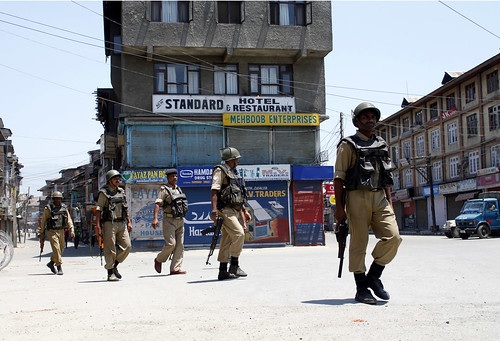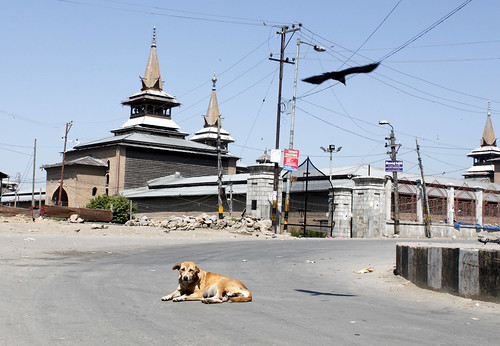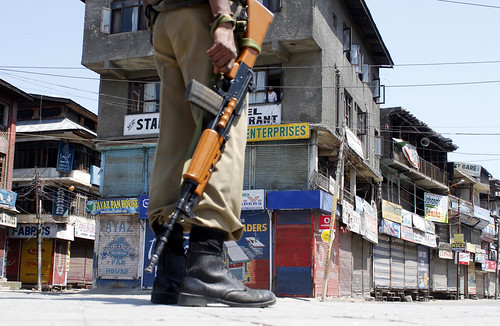By Yoginder Sikand, TwoCircles.net,
I’m back in Kashmir after a spell of three long years. Back to a curfewed Srinagar. The week before, the city observed a complete shut-down following the killing of a civilian by the Indian army in an alleged fake encounter. The next day the shut-down continued, this time in protest against Israel’s bombing of a relief ship heading to heavily blockaded Gaza. For the last two days in a row, shops and offices have been closed to greet the visiting Indian Prime Minister in a show of collective protest. We need to travel today to Anantnag (or ‘Islamabad’, as many prefer to call it) in south Kashmir, but we are not sure if we can—irate stone-pelting protesters are out on the streets of the town protesting the arrival of a consignment of underwear (from Bangladesh, according to one report, from the ‘West’, according to another). The controversial lingerie is said to contain blasphemous images, it is rumoured—of the holy cities of Arabia, people are led to believe, although a report in the papers claims that the pictures are of a church or a Christian monastery in England.
Finally, after much consultation, we leave for Anantnag, the driver cleverly taking a convoluted route through the mountains. We arrive late that evening to find the streets of the town—which has expanded vastly since I last visited it two decades ago—silent and deserted. Earlier in the day, protestors (including, some say, young boys who are paid to throw stones and force shops to down their shutters) fought pitched battles with the police, in which numerous civilians were injured, some grievously so. I am nervous and jittery, but my companion, employed with an NGO whose work in Anantnag I have come to write about, boisterously jokes: ‘This is harmless stuff. It happens every other day.’ I fail to see the joke and the point of the seemingly endless hartals—they harm the local economy and inconvenience the locals without doing the slightest damage to the armed forces or the state, ire against which continues unabated across Kashmir. I keep my opinions to myself, however.

The curfew is still in force the next morning. Today’s strike is to protest against a photographer who is said to have put up nude pictures of some local girls on the Internet. Teams of heavily-armed policemen patrol the streets, but we manage to leave the town somehow. We drive through a twisted, narrow road, lined on either side with plots of parrot-green paddy, ready to be transplanted, and slender trees aching with their burden of fruits and nuts. The flat valley floor stretches till the feet of wooded slopes that are draped with dense pine forests, behind which stand the majestic, perennially snowcapped peaks of the Himalayas. It is a picture of perfect serendipity, misleading in its haunting beauty, because every pretty little hamlet we pass has its own share of devastating traumas that remain untold: of men and women killed or maimed for life—by the army or by militants or by ‘renegades’.
We stop for a light breakfast of soggy pakoras and tea at Kokernag, where we pay a hurried visit to the famed Mughal gardens, a truly paradisical treat: endless stretches of pasture-like lawns and beds bursting with a hundred different types of flowers
in full bloom, criss-crossed with narrow glacial brooks that tumble forth from the forbidding mountains in the background. We drive further into the mountains, through dense coniferous forests till we arrive at the unassuming village of Sonabrairi: a collection of several dozen houses set amidst terraced rice fields, home to some 3500 people.
A wonderful setting for a picnic, it seems, but this little settlement, inhabited mainly by Gujjar herdsmen, most of whom have long since abandoned the nomadic ways of their forefathers, is, like numerous other hamlets in its vicinity, a devastated yet mute victim of a deadly war that has been waged for over two decades and that shows no sign of cooling off—the deadly, and probably unsolvable, Kashmir conflict. Almost forty of Sonabriri’s inhabitants—mostly male, some not yet even in their teens—have
been shot dead over the years—by the Indian army or by militants.
The latest such incident took place just about a fortnight ago, when a man from the village was killed in the distant town of Shopian. Apparently, he had earlier joined a militant Islamist outfit and crossed over to Pakistan for training, where he had spent almost eight years. Disillusioned with life in that country, he had returned to Kashmir two years before, and to his village nine months earlier. Then, two weeks ago he received a mysterious phone call from someone in Shopian, who had asked him to meet him there. He had hurried to the town, only to be shot dead.

Action Aid—the international organization that my friend works with—has been active in some of the villages of Anantnag for almost two years now. It has a modest project, funded by the European Community and routed through a local partner, the
New Kashmir Women and Child Welfare Society, to help the families of victims of violence in Sonabriri and its neighbouring settlements, particularly the poorest among them, by providing alternate forms of livelihood as well as psycho-social counseling. The aim of the former is not to lift the people out of poverty—that is the duty of the state—but, rather, to keep them gainfully engaged so that, as my companion explains, their minds, haunted by the memory of the ones they have lost, ‘can be somewhat
lightened’.
35-year old Mohammad Amin is one of the denizens of Sonabriri that Action Aid works with. This father of four toiled in Jammu as a daily-wage labourer for several years but now runs a small provision store provided to his mother, a heart patient, by the NGO. His younger brother, who joined a militant group, was shot dead by the Indian Army somewhere in the remote mountains of Poonch, near the Pakistan border. The economic fortunes of the family haven’t dramatically changed with the store, but at least Amin can now stay at home to nurse his mother, rather than being forced to work in a sweatshop in a city hundreds of kilometers from his village.
A handsome young lad, 15-year old Bilal is new at his job, having given up daily wage labour just a fortnight ago, for which he earned a paltry 50 rupees for a day of backbreaking work. He, too, runs a store in the village, for which the NGO provided the initial capital, in the form of goods worth Rs. 19,000. He excitedly points out the items neatly set on wooden shelves that line his box-like shop—chocolates, soap, tea, notebooks and flour. His father was killed by the army when he was barely two, accused of sheltering militants.
Lal Khan and his wife live in a hovel, set against the crumbling ruins of what was once their home. It is dark inside, and gloomy. We settle down on the carpeted floor, and, despite their heart-wrenching poverty, they insist we should partake of tea and
biscuits. Lal Khan’s wife collapses in a heap even before we start talking, sobbing and coughing uncontrollably and slapping her head with her bony hands. Lal Khan’s cheeks are stained with tears that trickle down his bearded chin as he draws out a tiny
diary from his breast pocket and flips it open. ‘I had four sons and they were all killed by the army’, he recounts as his wife shakes and shrieks. Three of his sons were indeed militants, he says. The second and third took to militancy after Lal Khan was arrested and brutally tortured after his first son was shot dead in an encounter. But the fourth son, just a young lad of thirteen, had not joined any militant outfit—he was shot dead when he had travelled to a neighbouring village to attend a marriage party. Lal Khan prises open his torn wallet and shows me a picture of the boy: he has large, buttery eyes, a sharp nose and a broad, handsome forehead.

Lal Khan once was fairly well-off by village standards, but then his two houses and three cowsheds, he says, were all destroyed by the army as a deterrent and punishment. This, and the loss of all the breadwinners of his large family (including five grandchildren who live in the same house) had driven the family to the verge of complete destitution. The NGO recently provided one of Lal Khan’s two sons-in-law a provision store, and although it probably won’t solve their grueling poverty, it might make a bit of a difference.
While families of people slain by militants in Kashmir are entitled to a modest compensation or relief by the state, those like Lal Khan’s, relatives or dependents of slain militants, are not. ‘Even if the government offered us any money, I would refuse to accept it,’ Lal Khan stoutly insists. In and around Sonabriri, it is only the coercive face of the state that people get to see: the ubiquitous army and the police. The state’s much touted-about welfare promoting role is conspicuous by its absence. The only state-funded developmental activities that folk I spoke to could indicate were paltry: an annual grant of a pathetic sum of money to children below the poverty line (Rs. 220 for boys and Rs. 360 for girls), and a mid-day meal programme in the local school (but here, too, complaints abound: meat is meant to be served twice a week, but
this never happens). The militants, of course, have no economic agenda, and rumours of militant leaders based in Pakistan or their allies in Kashmir minting money for themselves in the name of ‘Islamic jihad’, and even cornering compensation money meant for the families of what they call shaheeds or ‘martyrs’ abound. In the absence of the state’s developmental agencies as well as any economic assistance from the state’s opponents, it is well-meaning NGOs, like the one I visited, and people’s own initiatives that are helping the victims of violence somehow cope with the traumatic memories of a conflict that shows no sign of abating.
[Photo by AIP]

